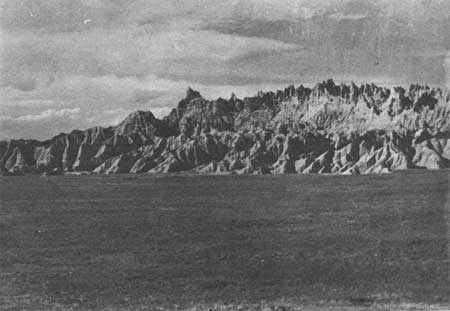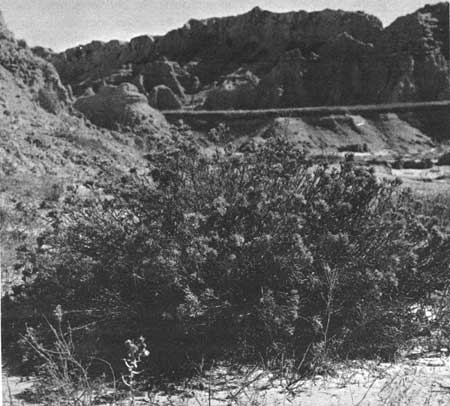|
BADLANDS National Park |
 |
Plants (continued)
GRASSES
The grasses, although not as colorful as the wildflowers, are a more important part of the ground cover. From them comes the food of the larger animals; within their protection many of the birds build their nests; because of them the topsoil is formed and grows in fertility; their covering mat retards erosion; and from their green mantle man derives great pleasure. The grasses of these plains have supported untold generations of grazing animals in astronomical numbers, from the camels and horses of the geologic past to the bison and pronghorns of the last century.
The various grassland types have developed because of differences in the environment, chiefly soil conditions, in which they grow. There are many such types referred to by the character and depth of soil. Here in the badlands are found representatives of nine types of range, of which four have special significance.
On the higher land, especially along the approach to the Badlands, is a good cover of upland vegetation. It contains principally BLUE GRAMA and NEEDLE-AND-THREAD. At lower elevations, however, the same type of site appears with these grasses subordinated by BLUESTEM ("western") WHEATGRASS and BUFFALOGRASS. The clay and thin-clay sites have a similar covering, with western wheat-grass, blue grama, and buffalograss predominating. The shallow site, as the name implies, consists of a patchy basal cover. Fairly dense stands of blue grama and buffalograss alternate with western wheatgrass. SIDEOATS GRAMA is also a major constituent.
 Grassy plain at the foot of the badlands wall |
Occasional patches of LITTLE BLUESTEM can be spotted by its reddish color after curing in midsummer. Commonly mixed in with the grasses is the grasslike THREADLEAF SEDGE. At sandy and heavy-soiled sites, the PRAIRIE SANDREED is conspicuous by its unusual height above the other grasses.
The grasslands, or prairies, were once the most extensive plant-type areas of the North American continent. Cultivation, grazing, fire, urbanization, and other factors have so removed or modified these vast areas of grassland that little now remains in essentially its natural condition. The importance of preserving grassland types in Badlands National Monument lies in the opportunity provided present and future visitors to see samples of this cover which is so rapidly disappearing from the American scene. Protection of grasslands in the monument permits study and comparison with other areas that have been greatly modified. The results can be of value in working out methods of better management, for many rangelands are badly damaged through overuse and their yield reduced as much as half their normal potential.
 Rabbitbrush |

|

|
| NPS History | History & Culture | National Park Service | Contact |
|
Last Modified: Sat, Nov 4 2006 10:00:00 pm PST |


